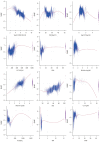Artificial intelligence predicts direct-acting antivirals failure among hepatitis C virus patients: A nationwide hepatitis C virus registry program
- PMID: 38195113
- PMCID: PMC10776298
- DOI: 10.3350/cmh.2023.0287
Artificial intelligence predicts direct-acting antivirals failure among hepatitis C virus patients: A nationwide hepatitis C virus registry program
Abstract
Background/aims: Despite the high efficacy of direct-acting antivirals (DAAs), approximately 1-3% of hepatitis C virus (HCV) patients fail to achieve a sustained virological response. We conducted a nationwide study to investigate risk factors associated with DAA treatment failure. Machine-learning algorithms have been applied to discriminate subjects who may fail to respond to DAA therapy.
Methods: We analyzed the Taiwan HCV Registry Program database to explore predictors of DAA failure in HCV patients. Fifty-five host and virological features were assessed using multivariate logistic regression, decision tree, random forest, eXtreme Gradient Boosting (XGBoost), and artificial neural network. The primary outcome was undetectable HCV RNA at 12 weeks after the end of treatment.
Results: The training (n=23,955) and validation (n=10,346) datasets had similar baseline demographics, with an overall DAA failure rate of 1.6% (n=538). Multivariate logistic regression analysis revealed that liver cirrhosis, hepatocellular carcinoma, poor DAA adherence, and higher hemoglobin A1c were significantly associated with virological failure. XGBoost outperformed the other algorithms and logistic regression models, with an area under the receiver operating characteristic curve of 1.000 in the training dataset and 0.803 in the validation dataset. The top five predictors of treatment failure were HCV RNA, body mass index, α-fetoprotein, platelets, and FIB-4 index. The accuracy, sensitivity, specificity, positive predictive value, and negative predictive value of the XGBoost model (cutoff value=0.5) were 99.5%, 69.7%, 99.9%, 97.4%, and 99.5%, respectively, for the entire dataset.
Conclusion: Machine learning algorithms effectively provide risk stratification for DAA failure and additional information on the factors associated with DAA failure.
Keywords: Algorithms; Antiviral agents; Artificial intelligence; Hepatitis C virus; Machine learning.
Conflict of interest statement
Ming-Lung Yu disclosed the following: research grant from Abbvie, Gilead, Merck, and Roche diagnostics; consultant for Abbvie, BMS, Gilead, Roche, and Roche diagnostics; and speaker for Abbvie, BMS, Eisai, Gilead, Roche, and Roche diagnostics.
Figures





Comment in
-
Toward hepatitis C virus elimination using artificial intelligence.Clin Mol Hepatol. 2024 Apr;30(2):147-149. doi: 10.3350/cmh.2024.0135. Epub 2024 Feb 23. Clin Mol Hepatol. 2024. PMID: 38390703 Free PMC article. No abstract available.
References
MeSH terms
Substances
Grants and funding
- Center For Intelligent Drug Systems and Smart Bio-devices
- Center of Excellence for Metabolic Associated Fatty Liver Disease, National Sun Yat-sen University, Kaohsiung
- MOST-111-2314-B-037-069-MY2/Ministry of Education
- MOHW111-TDU-B-221-114007/Ministry of Education
- KMUH-DK(B)111002-1/Ministry of Education
LinkOut - more resources
Full Text Sources
Medical

